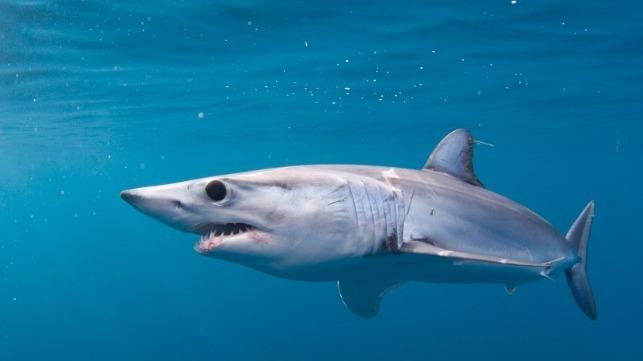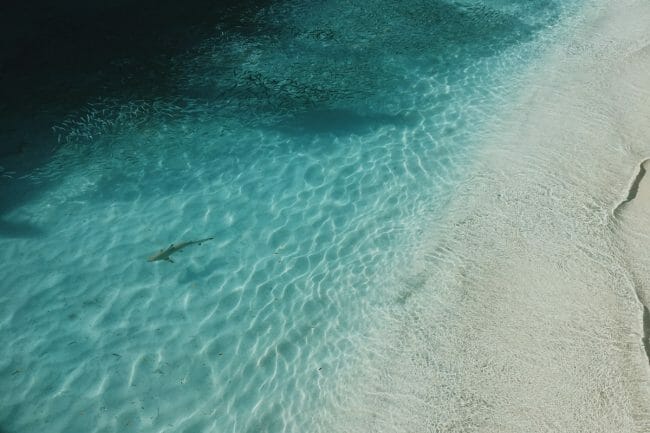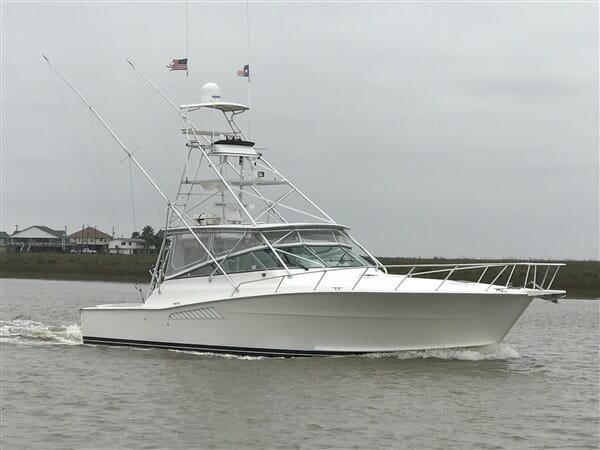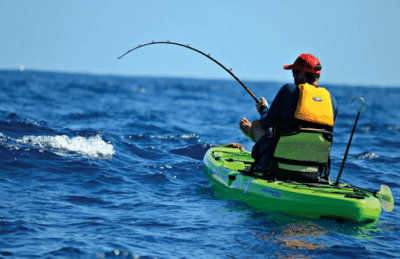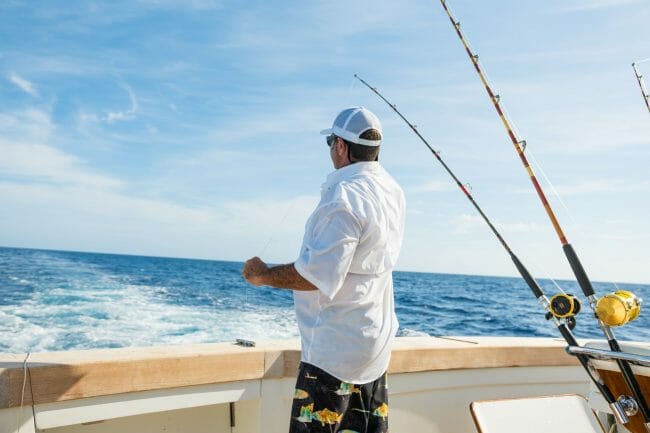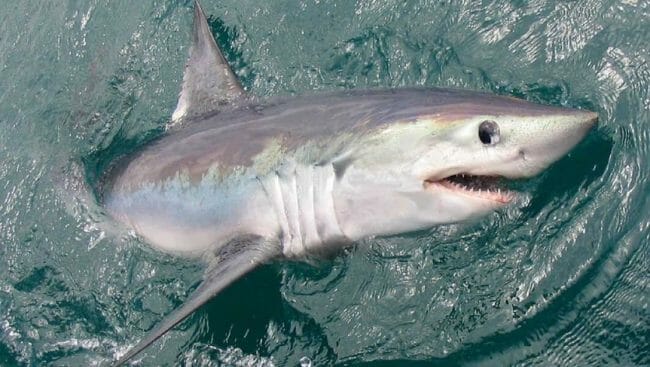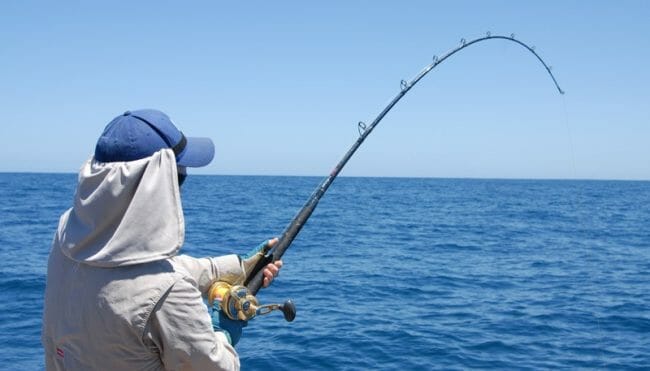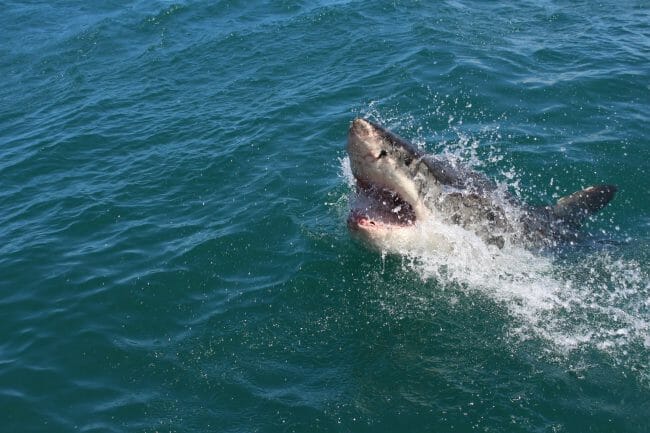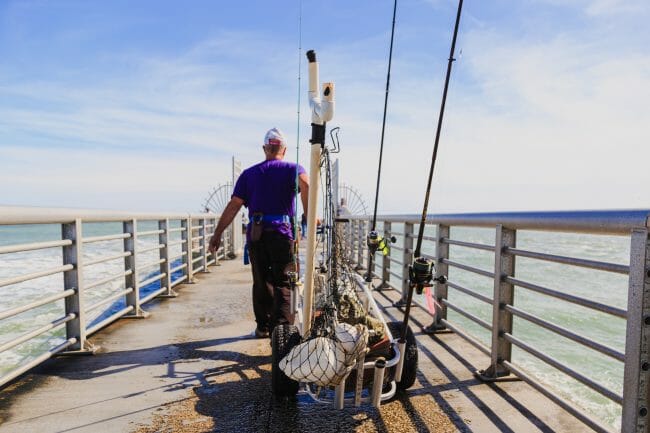Choosing a shark fishing rod will be mostly influenced by how you intend on fishing.
Will you be offshore on a boat or fishing from the shore on a pier or the beach?
Depending on your where you will be fishing will probably be the number one influencing factor on what type of shark rod you buy.
Regardless of the type the best shark fishing rods all need a strong backbone, rod blank and butt section not to mention high quality components such as reel seat line guides and tip guide.
On a cheap rod the first thing to go is usually either the line guides or the reel seat, it is rarely the rod blank that will fail first.
Regardless of the type of rod you choose it should be rated as a 50 lb class rod at a minimum.
Sharks need a rod that is capable of handling sustained pressure and can run heavy mono or braid at a minimum of 50 lbs breaking strain.
Ideally you will have enough power in the rod so that the fight does not go on for too long, as in most states for the majority of shark species the fishing is catch and release only.
The quicker you can unhook them the better their chances of surviving when released.
Shark Fishing Rods for Surf Fishing
Traditional surf fishing has changed considerably in the last ten years especially for larger species like shark.
A lot of anglers are now using either a kayak or more recently drones to haul their large shark baits out past the breaking surf some as far as several hundred feet beyond it.
This approach no longer requires a long surf casting rod. Instead they can opt to use slightly longer offshore conventional rods as no casting is required.
However, if you are just starting out then a surf casting rod will be the best option.
You can run either a spinning or a conventional as your choice of shark fishing reel on these big rods, but more often than not when fishing for sharks less than six feet spinning tackle is the more popular.
A longer surf casting rod for shark fishing gives has a number of advantages over a shorter rod:
- Better casting distance
- Keeps line high out of the waves
- Will be easier to detect a bite
Line guides should be ring guides only so you can use either mono or braid. Leave the roller guides to the heavier offshore shark poles.
Shark Fishing Rods for Offshore Fishing
A good offshore rod for shark will be a convention boat rod 5’6 to 6 feet with a moderate to fast taper the type that is commonly used with a harness.
You can choose either traditional ring guides or roller guides.
It is generally considered a bad idea to pair roller guides with braid as your main line because if the line slips the roller on to the side the roller will destroy the braid.
Monofilament is a lot more forgiving when used with rollers, the only downside is a little more stretch in your line making hook sets a little less sharper.
Some prefer a fast taper others a more moderate and this is normally a personal preference thing.
Best Shark Fishing Rods
The Penn Carnage 2 surf rods are available in either a spinning or conventional model and run from a 10′ to a 12′ in length. Power wise they range from a medium to an extra/heavy.
The medium/heavy is rated for 20 to 50 lbs line and weights in the 2 to 6 ounce range.
The extra/heavy is rated for line in the 50 to 80 lbs range and weights in the 6 to 12 ounce range.
They are specifically engineered for use with braided fishing line but can still use monofilament.
All models are a two piece design.
All rods have a moderate/fast tip action. A more moderate rod action will allow you to load more of the full length of the rod blank to cast heavier weights with more efficiency.
A faster tip will give you more sensitivity and allow you to detect bites easier.
The combination of moderate/fast is the best of both and is perfectly suited for casting weighted rigs for sharks out past the surf.
They are specifically designed with surf casting in mind and if you are looking to get out past the breaking surf then the longer rods will be the better option.
The only trade off with a longer shark rod is that it you hook a very large shark then you will have a longer lever to contend with whereas a shorter rod will give you more leverage to work against the shark.
Longer rods however cast better and once in your rod holder on the beach will also keep your line higher up over the surf and breaking waves making it easier to detect bites.
They are built on SLS3 rod blanks and have Fuij K guides with Alconite inserts, they also come with a high quality Fuji reel seat.
A classic style surf spinning rod that is aimed at performance casting.
The Tsunami Airwave range has been designed with lowering the weight of the rod as much as possible whilst still retaining a lot of backbone, durability and casting performance.
The Airwave is built on high-fiber density blanks that lowers the average weight without sacrificing on performance.
If you find yourself casting a lot throughout the day then the Airwave is a smart choice as a heavy rod can become tiresome after a long day casting through the surf.
The heavy rated rod is rated for line in the 20 to 40 lbs range and can throw weights in the 3 to 5 ounce range.
They come equipped with Pac Bay Aluminum oxide braid friendly guides and a lightweight Fuji graphite reel seat.
If you are looking for a rod that can be used for smaller sharks and still double up for lighter surf casting and other inshore work then the Mojo Surf line from St Croix is a safe bet.
The mojo range covers a large variety of techniques and species for both freshwater and saltwater fishing.
Not all shark fishing is about landing the next jaws and if your local beach, pier or dock has a healthy amount of smaller sharks in the sub 6 feet range then you can forget about needing a dedicated shark fishing rod and buy something that is usable for multiple different inshore fishing techniques.
The Mojo surf range as the name suggests if designed with surf casting in mind. St Croix are known for building exceptional rod blanks and the Mojo range is no exception.
They are built on St Croix’s SCII mid-modulus graphite fiber for lighter weight and premium sensitivity through the rod tip and down into the blank.
The heavy rated rods is suitable for line in the 10 to 20 lbs range and weights in the 1 to 4 ounce range, so these rods are clearly for small shark species.
The tip action is rated as a moderate/fast so you get the sensitivity of a fast action tip but still the better backbone and rod blank of a moderate rated rod that allows for more power to be transferred through the rod when casting.
Lightweight line guides with hardened zirconium inserts and a premium Fuji DPS reel seat for the hardware and twp coats of Flex-Coat slow cure finish to round out the rods.
If you are looking for a shorter boat rod that is not as heavy duty as some roller/conventional rods then a heavy duty spinning rod can be a great alternative.
Heavy duty spinning rods are a bit more versatile than a standup roller rod so you can target multiple species with these rods and a broader range of techniques.
The Shimano Talus is rated for line in the 50 to 100 lbs range and comes in at a length of 6’9″ making it very usable on a boat.
The tip section has a fast action for quick hook sets and better sensitivity whilst using single hooks on bait rigs.
They are designed for use with braided fishing line and feature Fuji Aluminum Oxide guides with a Shimano reel seat.
They are built on Shimano TC4 rod blanks which is their heavy duty rod technology for added durability.
The Shimano TLD A Stand Up is a classic style conventional roller offshore rod for big shark fishing.
Once you start to target larger species of shark a purpose built offshore rod really starts to make sense.
Big sharks put a massive strain on not only your rod blank and reel but also on the line guides and roller guides are one way to ensure that you line moves as smoothly as possible with the least amount of friction when under very heavy loads.
There are four rods available in the range a 20 lbs rod that has normal guides and then the 30, 50 and 80 lbs class rods which all feature roller guides.
Shark Fishing Rods
As we discussed above your choice of fishing rod for sharks will be determined by whether you are fishing from a boat or from the beach/pier.
All rod for shark fishing need to be well built with a lot of power through the rod blank and down into the butt section.
You also need to make sure that the reel seat and the line guides or rollers are of the highest quality to help reduce any friction between the line and the guides.
Shark fishing gear should last years of use and abuse if you buy quality from the beginning.
Surf Shark Rods
Assuming you are actually casting your bait out and not using a kayak to haul it out over the breaking surf then a long surf rod with a heavy power rating usually in the 50 to 80 lbs range is the best rod for the job.
Length
Personally I would not use a shark fishing pole for this type of fishing under ten feet in length.
A longer pole that is eleven or twelve feet long will have a number of advantages over a shorter rod.
A long rod once set into the rod holder will hold your line up high in the air above the crashing waves.
This also keeps the line high in the water off of the ocean floor free from any snags and also giving you a lot more feedback through the line.
You will also gain a notable amount of distance when casting. A longer rod is basically a much bigger lever and once you load the rod blank that lever becomes a huge spring that will help to whip a large bait and weight a lot further than any short rod can.
Action
Rod action describes where on the rod blank the rod will start to bend naturally once you apply some pressure to it.
A fast action will bend higher up the blank towards the tip.
What rod action for surf casting for sharks ?
A fast rod action is best when surf fishing for sharks from the beach or a pier. This is will give you the best casting characteristics but also a more sensitive tip for detecting bites.
Power
Given their size a heavy rod action is a must for all shark fishing. Look for rods that are rated from 50 to 80 lbs.
Anything smaller and although you may end up landing the shark chances are it will take a long time and a tired shark has a lot lower chance of surviving once released than one that is played quickly.
Offshore Shark Rods
Size
On a boat shorter is nearly always better so look for a good conventional offshore boat rod in that is either 5’5″ or 6′ in length.
A shorter rod give you a lot more leverage against a heavy shark and combined with a high torque reel(low gearing) you should be able to exert enough pressure to reel them in quickly.
High quality jigging rods or trolling rods will be required if you are targeting really big sharks.
Short poles are also a lot easier to use on a boat than a long rod unless you are trolling and running a lot of planer boars out wide.
Ring Guides vs Rollers ?
Roller assembly braid mono in rings no chaff
The main advantage that roller guides give you on big game rods is that they reduce the amount of friction between the line and the guide.
But if your line pops off onto the side of the roller it can make bits of your line especially if you are using braid.
Monofilament is the better option if you opt for a pole with roller guides.
Modern ring guides especially the higher end ones are so hard now that they will wear very little and cause very little friction against the line.
There is very little to go wrong with a simple ring guide assuming it is of a decent quality.
You do see a lot of anglers that use a roller guide on the tip and then ring guides on the rest of the rod but in my opinion this is a mistake.
You should either go all roller guides or all ring guides no mixing and matching as once you use one of the other type you loose the benefits of the type of guide.
Bent Butt or Straight ?
If you are new to offshore fishing then you may never have encountered a bent butt rod before.
These rods are for using in a fighting chair. One thing to remember that this kind of setup if not tournament legal and so if you intend on doing some tournaments then a straight butt rod is the way to go.
Straight butt rods can be used in a belt or harness.
A really high end expensive rods the butt will be solid aluminum and they can be flicked from the straight position into a bent but as there is a pivot point just below the reel seat.
Materials
Fiberglas or some form of modern fiberglass blend with either graphite or carbon fiber but straight up fiberglass is a pretty solid bet.
The standard of epoxy resin will also have an impact of the final quality of the rod.


